The dumbbell kickback is a strength-training exercise that targets the triceps muscle in the upper arm.
It is an effective exercise for building arm size and strength.
It is popular for those looking to tone and strengthen their tricep.
This blog will tell you everything you need to know:
- What is the dumbbell kickback,
- How to perform the exercise properly,
- The benefits it provides
- The common mistakes to avoid.
- Different ways to do the dumbbell tricep kickback
After reading this blog, you will better understand the dumbbell kickback and how it can help you achieve your bigger tricep.
Want to take your gains to the next level? Discover your daily calorie needs with our free TDEE calculator
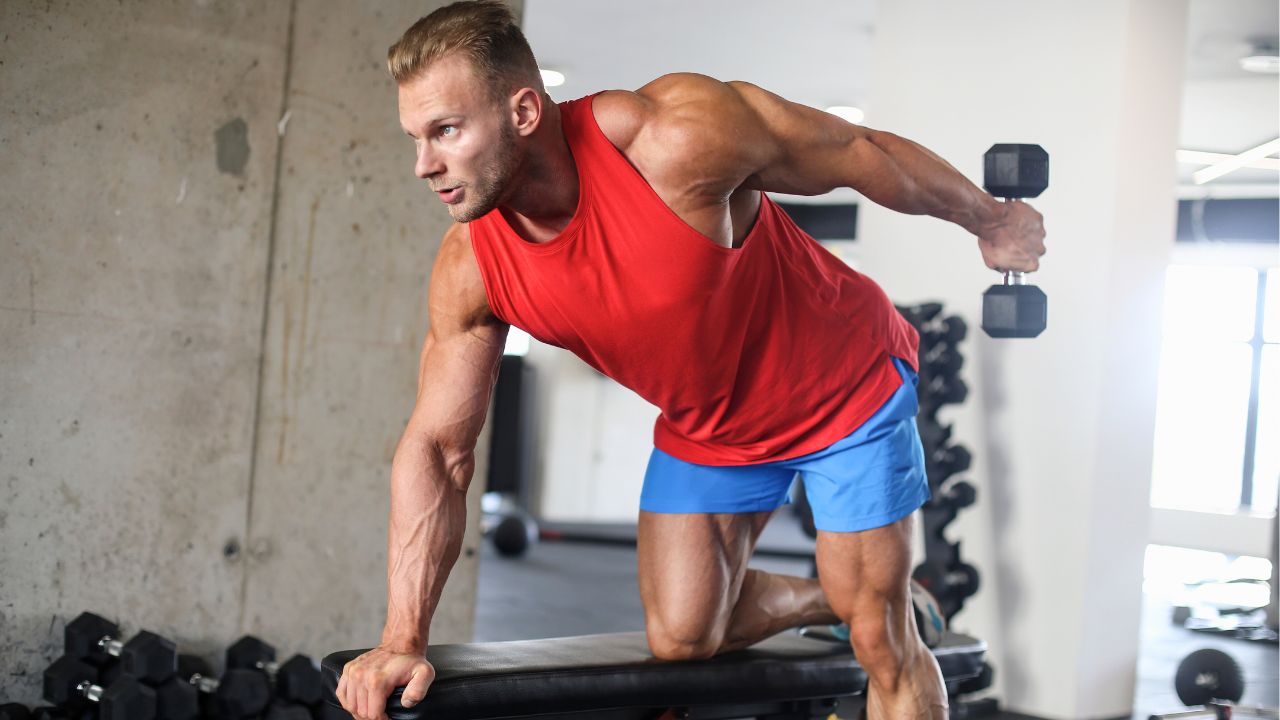
- What Is Dumbbell Triceps Kickback
- Muscle Worked During Dumbbell Tricep Kickback
- How To Do Tricep Kickback With Dumbbell
- Sets And Reps
- Form and Technique For Doing Kickback
- Best Variations Of DB Tricep Kickbacks
- 1. Seated Two Arm Dumbbell Kickback
- 2. Seated Single Arm Kickback
- 3. Standing Single Arm Dumbbell kickback
- 4. Two Arm Dumbbell Standing kickback
- 5. Incline Dumbbell Kickback
- Benefits Of Tricep Kickbacks
- FAQs
- Are dumbbell kickbacks effective?
- Does kickback work all 3 heads of the tricep?
- How many sets and reps of the kickback exercise should I do.
- Takeaways
What Is Dumbbell Triceps Kickback
The dumbbell tricep kickback is a versatile and effective exercise that targets the triceps muscles.
This exercise helps build strength and muscle in all three heads of the tricep muscle.
When you do a tricep workout with a dumbbell, kickback is one of the best single-arm exercises you can do to fix imbalances.
It can be performed using one arm at a time or using both arms simultaneously.
You can add more variations of the Dumbbell tricep kickback exercise to your workout routine if you like.
- Standing Dumbbell Tricep Kickback
- Seated Dumbbell Tricep Kickback
- One-Arm DB Tricep Kickback
- Two-Arm Dumbbell Tricep Kickback
- Incline Dumbbell Tricep Kickback

Muscle Worked During Dumbbell Tricep Kickback
The tricep dumbbell kickback primary muscle works on all three heads of the triceps (the long, medial, and lateral head)
In addition to the triceps, the exercise also works the rear deltoids and core to a lesser extent.
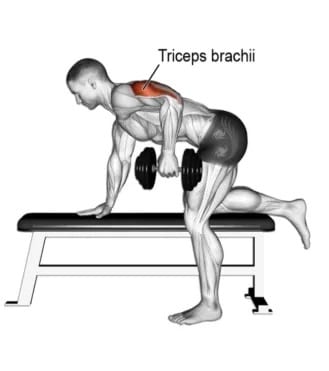
How To Do Tricep Kickback With Dumbbell
Here is a step-by-step guide to performing the dumbbell kickback:
- Pick a weight that’s right for you. A good starting point is usually between 5–15 pounds.
- Stand with your feet shoulder-width apart and hold a dumbbell in one hand.
- Bend forward at the waist and place your right hand and right knee on a bench.
- Your left foot should be at the side of the bench, with your left knee slightly bent.
- Keep your elbow still and extend your arm behind you as far as possible.
- Hold for a moment, then slowly return to the starting position.
- Repeat for the desired number of repetitions, then switch sides and repeat the exercise with your left arm.

Sets And Reps
Here are some general guidelines for the dumbbell kickback exercise, including sets, reps, and frequency, to enhance muscle mass
| Fitness Level | Sets | Reps | Frequency |
|---|---|---|---|
| Beginner | 2–3 sets per workout | 8-12 | 1–2 times per week |
| Intermediate | 3–4 sets per workout | 8-12 (slightly heavier) | 2–3 times per week |
| Advanced | 4–5 sets per workout | 8-15 | 2–3 times per week |
Form and Technique For Doing Kickback
While strength-building exercises provide you with numerous benefits, it’s a good idea to follow a few guidelines to maintain safety and prevent injury.
- Always warm up your arm for 5 to 10 minutes at the beginning to protect your elbows from excessive stress.
- Use the lowest weight available while you work on learning proper form and technique.
- Keep your body as still as possible; move only your forearms.
- Perform the full range of motion for optimal results.
- Keep your back straight and avoid arching excessively.
- Exhale as you extend your arm, and inhale as you return to the starting position.
- Taking off at least one or two full days per week is a good idea to allow your muscles time to rest and recover.
- As a general rule, always work your weakest side first. In most cases, this will be the left.
- Use smooth, steady, controlled movements instead of jerky and forceful ones.
- Make sure you’re able to maintain a smooth, natural breath throughout your routine.
Best Variations Of DB Tricep Kickbacks
The dumbbell kickback is a great way to build and shape the triceps muscles. The standing dumbbell kickback is the standard version, but there are several versions that have unique benefits.
You can target the triceps from various angles by modifying hand position, angle, stance, and other technique factors.
These kickback variations will help you strengthen your triceps from multiple angles and break through plateaus.
1. Seated Two Arm Dumbbell Kickback
The seated bent-over DB tricep kickback is a variation of the standing dumbbell kickback. Seated triceps kickbacks are an exercise used to isolate the triceps muscles.
The seated bent-over two-arm dumbbell kickback is a fantastic tricep isolation exercise that effectively builds size and strength in all three heads of the triceps.
You can also perform this exercise alternating one arm at a time.
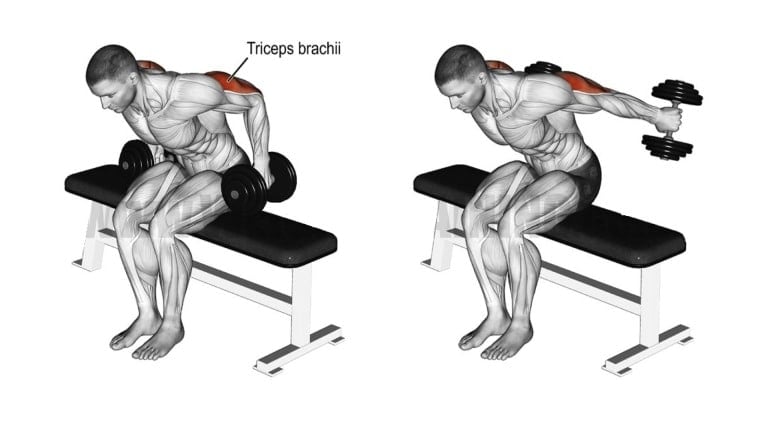
How To Do
- Sit on a bench and grab a pair of dumbbells using a neutral grip (palms facing your body).
- Keeping your upper arms fixed to your sides, lean forward until your torso is almost horizontal.
- Exhale as you extend the dumbbells behind you until your forearms are horizontal.
- Hold for a count of two and inhale as you slowly lower the dumbbells to the starting position.
2. Seated Single Arm Kickback
It is a unilateral variation of the traditional kickback that is performed while seated on a flat bench with one arm extended at a time. It helps to improve mind-muscle connection.
Taking sitting positions can help isolate the triceps, which can help minimize body movement.

How To Do
- Sit on a flat bench, and your feet are flat on the floor. Keep your back straight and chest up.
- Hold a dumbbell in one hand, with your palm facing in, and your elbow bent at a 90-degree angle.
- Keep your elbow stationary and extend your arm as far as possible behind you.
- Hold for a moment, then slowly return to the starting position.
- Repeat for 10–12 repetitions, then switch arms.
To Stay Motivated: 150+ Gym Workout Motivational Quotes To Stay Fit
3. Standing Single Arm Dumbbell kickback
Standing dumbbell triceps kickback is a variation of the traditional kickback that doesn’t require a bench. Compared to seated variations, this allows for a slightly deeper tricep extension.
By working on one side at a time, you also strengthen your core and body for stability.
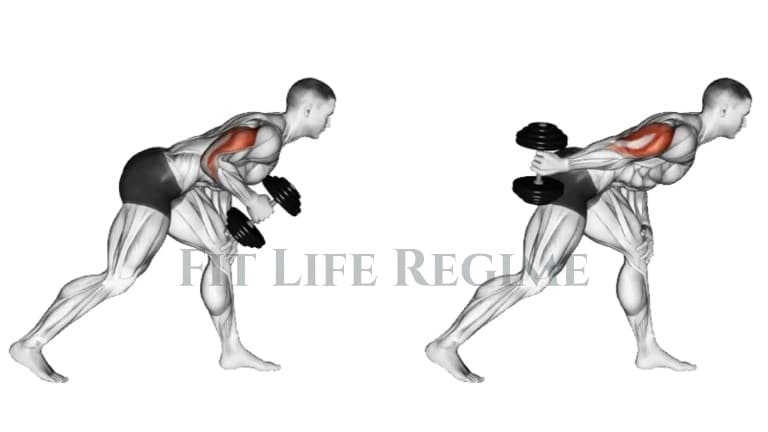
How To Do
- Stand with your feet shoulder-width apart and hold a dumbbell in one hand.
- Keep your back straight as you bend forward at the waist.
- Grab a dumbbell with your right hand, then shift your left foot forward and your right foot backward.
- Kick your right elbow back so the upper arm is almost parallel to the ground, and let it go until it’s fully extended.
- Slowly lower the dumbbell back to the starting position.
- Complete all reps on the right arm and then repeat on the left.
4. Two Arm Dumbbell Standing kickback
The standing two-arm dumbbell triceps kickback is performed with both arms extended simultaneously while standing.
Working both arms simultaneously helps promote balance and symmetry in triceps development.
It is a great exercise for strengthening the triceps and improving arm stability.
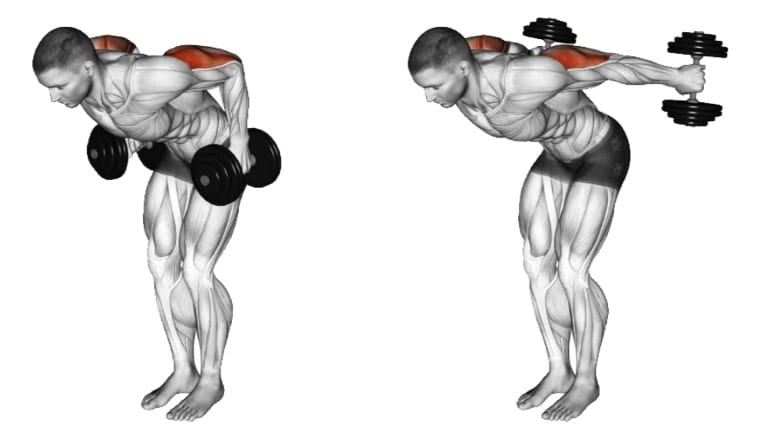
How To Do
- Stand with your feet shoulder-width apart.
- Hold a dumbbell in each hand and bend your upper body forward at the hips.
- Keep your back straight and your chest up.
- Bend your elbows to 90 degrees and position your upper arms parallel to the floor.
- Extend your arms back and squeeze your triceps.
- Then, slowly return to the starting position.
- Perform 2 to 3 sets of 10 to 12 reps.
5. Incline Dumbbell Kickback
The incline kickback, also known as the chest-supported kickback, is a variation of the traditional dumbbell kickback that is performed while lying on an incline bench.
This modification changes the angle of the exercise, which might change the way the tricep muscle is engaged.
Keeping your chest supported helps reduce the strain on your lower back, and you can now stretch and contract your triceps more easily.
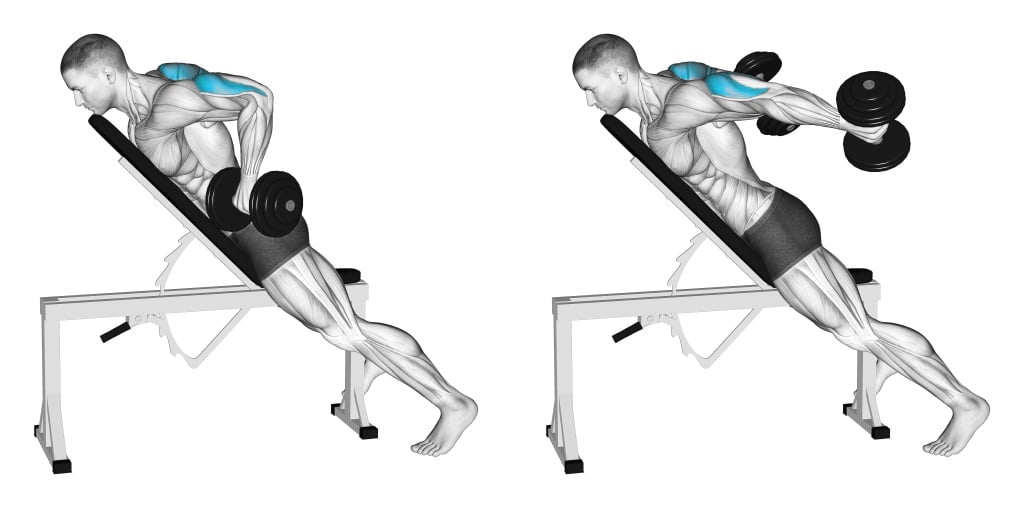
How To Do
- Set an incline bench to a 45-degree angle.
- Lie face down on an incline bench, with your chest supported by the bench.
- Hold a dumbbell in each hand, with your palms facing each other and your elbows bent at a 90-degree angle.
- Keep your elbow still and extend your arm behind you as far as you can.
- Hold for a moment, then slowly return to the starting position.
- Repeat for 10–12 repetitions per arm.
- Then, switch sides and repeat the exercise with your other arm.
Benefits Of Tricep Kickbacks
The few advantages of performing dumbbell kickback triceps are:
- It is highly versatile as you can adjust it to your current fitness level.
- Dumbbell kickbacks build functional strength by improving the flexibility and stability of your arms and shoulders.
- It requires limited space with no other special equipment; it is a perfect workout at home option for people who cannot afford to hit the gym daily.
- A dumbbell kickback is the best exercise to stimulate all three heads of the triceps while straining the lateral head a little more.
- It is the best warm-up exercise for other advanced tricep exercises. For example, you can perform this and then move to a diamond push-up, which will be effortless to accomplish.
- It increases the upper body movement and range, thereby helping you perform your lifting, swimming, boxing, rowing, and other pushing activities efficiently.
- Doing multiple sets of triceps kickbacks can improve endurance in the triceps.
FAQs
Are dumbbell kickbacks effective?
Yes, dumbbell kickbacks can be effective for targeting and strengthening the triceps muscle.
When performed with proper form and technique, and combined with a well-rounded strength training program, kickback can help to build and tone the triceps.
Does kickback work all 3 heads of the tricep?
Yes, dumbbell triceps kickbacks work all three heads of the triceps muscle, including the lateral head, medial head, and long head.
How many sets and reps of the kickback exercise should I do.
The number of sets and reps for triceps kickbacks can vary depending on your goals and experience level.
As a general guideline, you can aim for 3–4 sets of 8–12 reps per arm, with 30–60 seconds of rest between sets.
Takeaways
I think the dumbbell triceps kickback is a great exercise to add to your workout routine, whether you’re a beginner or an experienced fitness enthusiast.
It is a highly effective exercise for targeting and strengthening the triceps muscle.
There are several ways to do the dumbbell triceps kickback. Choose the one that works best for you.
References
- Tanton LC, Cappaert TA, Gordon PM, et al. Strength, Size, and Muscle Quality in the Upper Arm following Unilateral Training in Younger and Older Males and Females. Clinical medicine Arthritis and musculoskeletal disorders. 2009;2. doi:10.4137/CMAMD.S1180
- Boehler, B A. “Electromyographic analysis of the triceps brachii muscle during a variety of triceps exercises.” (2011).

Manish brings over 10 years of hands-on experience in weight lifting and fat loss to fitness coaching. He specializes in gym-based training and has a lot of knowledge about exercise, lifting technique, biomechanics, and more.
Through “Fit Life Regime,” he generously shares the insights he’s gained over a decade in the field. His goal is to equip others with the knowledge to start their own fitness journey.
